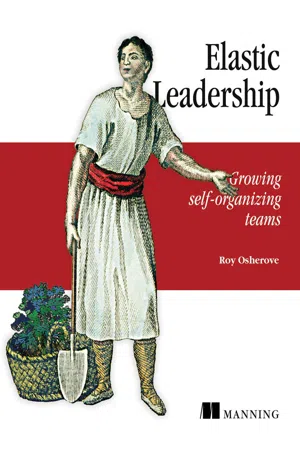
- 240 pages
- English
- ePUB (mobile friendly)
- Available on iOS & Android
About this book
Summary Elastic leadership is a framework and philosophy that can help you as you manage day-to-day and long-term challenges and strive to create the elusive self-organizing team. It is about understanding that your leadership needs to change based on which phase you discover that your team is in. This book provides you with a set of values, techniques, and practices to use in your leadership role.Purchase of the print book includes a free eBook in PDF, Kindle, and ePub formats from Manning Publications. About the Technology Your team looks to you for guidance. You have to mediate heated debates. The team is constantly putting out fires instead of doing the right things, the right way. Everyone seems to want to do things correctly, but nobody seems to be doing so. This is where leaders get stuck. It's time to get unstuck! Elastic leadership is a novel approach that helps you adapt your leadership style to the phase your team is in, so you can stay in step as things change. About the Book Elastic Leadership is a practical, experience-driven guide to team leadership. In it, you'll discover a set of values, techniques, and practices to lead your team to success. First, you'll learn what elastic leadership is and explore the phases of this results-oriented framework. Then, you'll see it in practice through stories, anecdotes, and advice provided by successful leaders in a variety of disciplines, all annotated by author and experienced team leader, Roy Osherove. What's Inside
- Understanding why people do what they do
- Effective coaching
- Influencing team members and managers
- Advice from industry leaders
About the Reader This book is for anyone with a year or more of experience working on a team as a lead or team member. About the Author Roy Osherove is the DevOps process lead for the West Coast at EMC, based in California. He is also the author of The Art of Unit Testing (Manning, 2013) and Enterprise DevOps. He consults and trains teams worldwide on the gentle art of leadership, unit testing, test-driven development, and continuous-delivery automation. He frequently speaks at international conferences on these topics and others. Table of Contents
PART 1 - UNDERSTANDING ELASTIC LEADERSHIP
- Striving toward a Team Leader Manifesto
- Matching leadership styles to team phases
- Dealing with bus factors
PART 2 - SURVIVAL MODE
- Dealing with survival mode
PART 3 - LEARNING MODE
- Learning to learn
- Commitment language
- Growing people
PART 4 - SELF-ORGANIZATION MODE
- Using clearing meetings to advance self-organization
- Influence patterns
- The Line Manager Manifesto
PART 5 - NOTES TO A SOFTWARE TEAM LEADER
- Feeding back
- Channel conflict into learning
- It's probably not a technical problem
- Review the code
- Document your air, food, and water
- Appraisals and agile don't play nicely
- Leading through learning: the responsibilities of a team leader
- Introduction to the Core Protocols
- Change your mind: your product is your team
- Leadership and the mature team
- Spread your workload
- Making your team manage their own work
- Go see, ask why, show respect
- Keep developers happy, reap high-quality work
- Stop doing their work
- Write code, but not too much
- Evolving from manager to leader
- Affecting the pace of change
- Proximity management
- Babel Fish
- You're the lead, not the know-it-all
- Actions speak louder than words
Frequently asked questions
- Essential is ideal for learners and professionals who enjoy exploring a wide range of subjects. Access the Essential Library with 800,000+ trusted titles and best-sellers across business, personal growth, and the humanities. Includes unlimited reading time and Standard Read Aloud voice.
- Complete: Perfect for advanced learners and researchers needing full, unrestricted access. Unlock 1.4M+ books across hundreds of subjects, including academic and specialized titles. The Complete Plan also includes advanced features like Premium Read Aloud and Research Assistant.
Please note we cannot support devices running on iOS 13 and Android 7 or earlier. Learn more about using the app.
Information
Part 1. Understanding elastic leadership
You can’t depend on your eyes when your imagination is out of focus.Mark Twain
Chapter 1. Striving toward a Team Leader Manifesto
The reasonable man adapts himself to the world; the unreasonable one persists in trying to adapt the world to himself. Therefore all progress depends on the unreasonable man.George Bernard Shaw, Man and Superman
- Principles of leadership
- How to become and remain a good leader
- Developing other leaders from your peers—growing people
- I could have been a bit more courageous and said, “I don’t know how to fix this,” early on.
- We could have had daily stand-ups where my predicament would have been discovered early.
- We could have had a rule whereby no one was allowed to work on something on their own for more than a day.
- My team leader could have approached me and done one-on-one meetings weekly or biweekly to discover what was up.
Why should you care
Don’t be afraid to become management
You can make time for the things you care about
Take the opportunity to learn new, exciting things every day
Experiment with human beings
Table of contents
- Copyright
- Brief Table of Contents
- Table of Contents
- Preface
- Acknowledgments
- About this Book
- Part 1. Understanding elastic leadership
- Part 2. Survival mode
- Part 3. Learning mode
- Part 4. Self-organization mode
- Part 5. Notes to a software team leader
- Index
- List of Figures